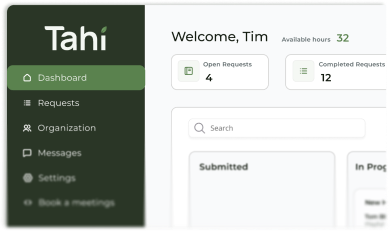SEO & Analytics
Is Your Website Truly Working? 7 Questions Before a Redesign
Thinking about a website redesign? Ask these 7 data-backed questions to decide if your site is helping or hurting your business. Your guide to clarity.

Your Website Should Be Your Best Employee
Think of your website as your hardest-working employee. It's your digital storefront, your top salesperson, and your brand ambassador, working 24/7. But like any employee, it needs regular performance reviews. Many businesses feel their website is underperforming, yet they struggle to pinpoint why. They know something is wrong, but the path to fixing it feels foggy.
A redesign is often seen as the go-to solution, but embarking on one without a clear diagnosis is like prescribing medicine without knowing the illness. It leads to wasted resources and a new site that might inherit the old one's problems.
At Tahi Studio, we believe in clarity and building solid foundations. So, before you dive into a redesign, let's review your website's performance together. Here are seven crucial questions, backed by data, to help you understand if your website is truly working for you.
1. Is Your Page Speed Costing You Customers?
First impressions are everything, and online, they happen in seconds. Literally. If your website is slow, you are actively turning customers away. Research shows that a mere one-second delay in page load time can reduce conversions by 7%. For a business making $100,000 per day, that one-second delay could cost over $2.5 million in lost sales every year.
Consider these stats:
- 53% of mobile users will abandon a site that takes longer than three seconds to load, according to Google.
- The average top-performing website loads in under 1.7 seconds. How does yours compare?
Slow speed is more than a minor inconvenience; it's a direct hit to your bottom line and brand perception. It communicates a lack of care and professionalism. Before anything else, you must ask if your site's speed is respecting your user's time or costing you their business. This is where understanding page speed optimisation becomes critical.
2. How Does Your Website Perform On Mobile?
Having a "mobile-responsive" site is no longer an achievement; it's the bare minimum. While around 90% of websites now use responsive design, mobile bounce rates remain alarmingly high at 51%. This tells us that simply shrinking a desktop site to fit a smaller screen isn't enough.
A true mobile experience is about usability and context. Ask yourself:
- Can users easily tap buttons and navigate menus without pinching and zooming?
- Is the text legible without effort?
- Is the most important information prioritised for a user on the go?
With mobile-optimised sites dominating 62% of top-ranking positions in search results, a poor mobile experience doesn't just frustrate users, it makes you invisible to them. Your site must be genuinely crafted for the mobile user, not just adapted for them.
3. Is Your User Experience Helping or Hindering?
A great user experience (UX) guides your visitors seamlessly towards their goal. A poor one is like a maze with no exit. The impact is staggering. While great UX can quadruple conversion rates, a confusing or cluttered layout will drive 38% of visitors away immediately.
First impressions are 94% design-related, but this isn't just about aesthetics. It's about structure and intuition. Can a new visitor understand what you do and where to go within five seconds? Is your navigation logical? Is your layout clean and focused? According to one study, a cluttered webpage can slash conversions by a shocking 95%.
For e-commerce, this is especially critical. Around 70% of shopping cart abandonments are due to UX friction, like forcing users to create an account or presenting them with too many form fields. Your website's design should feel like a helpful guide, not an obstacle course. This is where understanding good information architecture makes all the difference.
4. Are Your Calls to Action Actually Clear?
You can have the fastest, most beautiful website in the world, but if you don't tell users what to do next, they will do nothing. A Call to Action (CTA) is the crucial instruction that moves a visitor from passive browsing to active engagement. Yet, an incredible 70% of small business websites lack any CTAs.
It's no surprise that low conversion rates are the trigger for over 80% of website redesigns. Your CTAs ("Book a Demo," "Shop Now," "Download the Guide") are the signposts on the customer journey. They need to be:
- Visible: Using contrasting colours and clear placement.
- Compelling: Using action-oriented language that communicates value.
- Logical: Placed at points where the user is ready to take the next step.
Review every page on your site. Is it crystal clear what the next step is? If not, you're leaving growth on the table.
5. Does Your Content Attract and Engage?
Your website is a platform for your expertise. Strategic content is what turns a digital brochure into a powerful lead-generation engine. It builds trust, demonstrates authority, and attracts your ideal clients through search engines. Businesses that publish 16 or more blog posts per month get around 3.5 times more traffic than those that publish four or fewer.
But it's not just about quantity. Your content must be genuinely helpful. Does it answer your customers' biggest questions? Does it solve their problems? Incorporating different formats, like video, can also make a huge difference, increasing the average time a visitor spends on your page by 88%.
A website without a thoughtful content strategy is a silent salesperson. An effective site speaks directly to its audience, building a relationship long before a sale is ever made. This is where having a solid SEO strategy becomes essential.
6. Does Your Site Truly Reflect Your Brand?
Your business has likely evolved since your website was first built. You've refined your services, honed your values, and raised your standards. Does your website reflect the quality and professionalism of your business today?
An outdated design, old messaging, or inconsistent branding creates a disconnect. It erodes trust before you've had a chance to build it. A potential client might see the high quality of your work or service elsewhere, but if they land on a dated website, that confidence falters. Your digital presence should be an authentic representation of your brand's current identity and ambition. If it feels like it belongs to a past version of your business, it's holding you back.
7. Is Your Website Built for the Future?
The digital landscape is constantly changing. A modern website shouldn't just serve your needs today; it must be scalable for tomorrow. This means being built on a flexible platform that allows you to grow without being trapped.
Consider this: can you easily update content yourself without needing a developer for every small change? Can you integrate new tools, like a CRM or marketing automation software, without a complete overhaul? With 89% of business leaders seeing personalisation as key to future success, your site needs the technical foundation to support more sophisticated strategies.
Platforms like Webflow provide this exact flexibility, empowering teams with a powerful Content Management System while allowing for deep customisation and integration. Your website should be a dynamic asset that evolves with your business, not a static monument that holds it back.
Moving Forward with Clarity
Answering these questions honestly provides the clarity needed to make a strategic decision. A redesign should never be just a facelift; it's a business investment aimed at solving specific problems and achieving measurable goals.
It's about building a solid digital foundation that works for you, day in and day out. If you've gone through this list and realised your website is indeed underperforming, the next step is to partner with a team that can help you build it right. A team that believes in partnership, transparency, and uncompromising quality.
Ready to discover what your website could be achieving? Explore our strategic approach or start with a free site audit to get the clarity you need to move forward with confidence.








